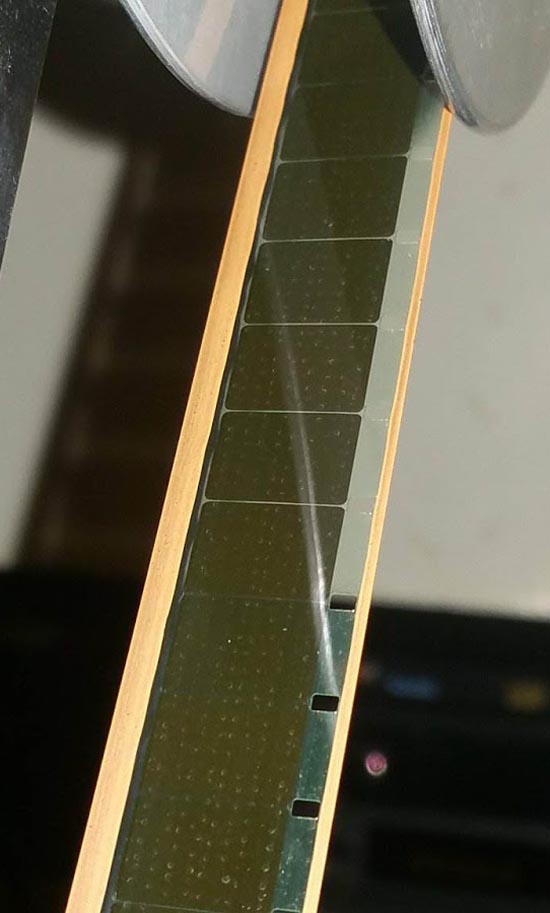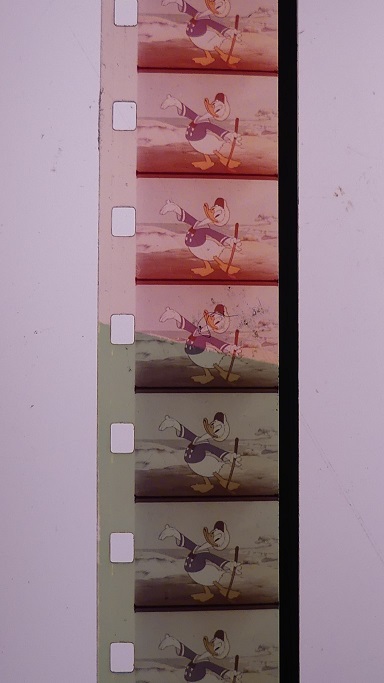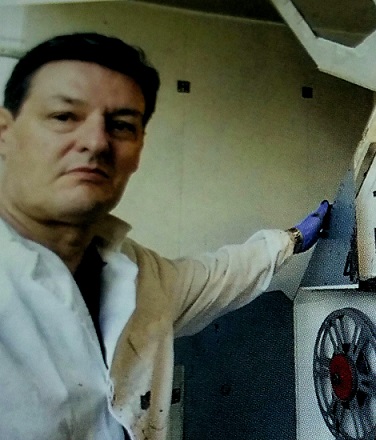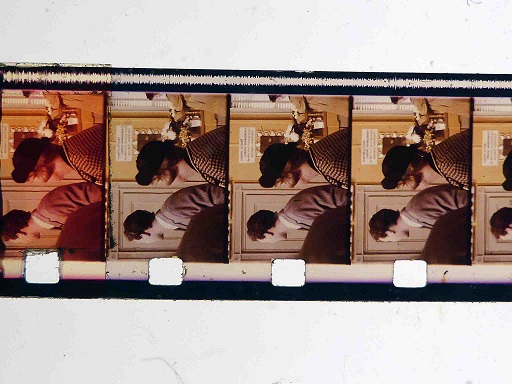|
Author
|
Topic: Process to Restore color to faded prints
|
Rich Malmsten
Film Handler
Posts: 41
From: White Bear Lake, MN, USA
Registered: Feb 2017
|
 posted May 23, 2019 11:45 AM
posted May 23, 2019 11:45 AM




There’s been some discussion on the 16mm forum regarding a chemical process to restore color balance to faded Eastman prints. Below is a link to the website discussing this process.
https://mimundoensuper-8.blogspot.com/2019/05/ors-chemical-system-solution-to-red.html
I’m wondering if this process, if it works as well as described, might not be particularly useful for our faded Super 8 prints. Like many of us, I have many faded digests that were never released on low fade stock. For about 55$US, four 400-ft digests could be processed. I do use filters to help with the color, but for $15 per film, I’d consider getting my faded digests of “Star Wars” and “This Island Earth” done.
The firm doing this is Movie Magnetics in Italy, the firm now striping films, so no fly by night outfit. I’ve been pleased with the striping they’ve done for me, and that adds to their credibility for me. I’ll be seriously considering trying this process as an experiment (probably after I get another reel of silent prints mag-striped later this year).
| IP: Logged
|
|
|
|
|
|
|
|
Nantawat Kittiwarakul
Master Film Handler
Posts: 280
From: Rajburana, Bangkok, Thailand
Registered: Aug 2017
|
 posted May 23, 2019 08:17 PM
posted May 23, 2019 08:17 PM




Quoted:
"1) In phase one, it removes the fading, with the red being subtracted in a chemical process!!!
2) in phase two, adjusts the contrast as much as possible. "
Simply put,this process seems like it first reducing the Magenta level to (more or less) the same as Cyan/Yellow,then re-boosting all 3 layers back again.
So if there's little or no Cyan/Yellow left,it's impossible to regain the correct color balance anyway. ![[Roll Eyes]](rolleyes.gif)
And since this seems to be irreversible process,ones should consider that risk too.
--------------------
Just a lone collector from a faraway land...
| IP: Logged
|
|
Brad Miller
Administrator

Posts: 525
From: Dallas, TX, USA
Registered: Jun 2003
|
 posted May 25, 2019 11:00 AM
posted May 25, 2019 11:00 AM




Use a gel in front of the lens. It's going to give you a better result, as you can change the color of the gel during projection to determine exactly which gel color to use to achieve the best effect on a film-by-film basis (and also for color temperature differences between halogen, vs. xenon light sources).
Whatever this guy is doing is pretty much BEGGING for Vinegar Syndrome to kick in, as he is clearly putting some sort of permanent coating onto the film, which means it will not be able to breathe properly and your film will turn to VS much, much sooner than it otherwise would have.
The way I see it, he is essentially "painting" the film with a mostly-transparent light blue/green paint. (In reality the film is probably being unwound and passed through a tank, dipping the film into the "paint" type of solution, but still...this is a bad, bad idea.)
Furthermore, the color will still continue to fade, and as it fades worse, this "paint" type of solution will not be adjustable, unlike simply using a gel in front of the lens.
BTW, for the claim to increasing contrast, the gel will do the exactly the same thing.
In other news, a link to the guy's webpage shows this photo of film after he has applied the magnetic audio tracks...

What you see there are water spots from a lack of a proper wetting agent in the final rinse here. That's also bad news. His "before" photo did not have these spots, so I can only assume it is happening with the film in his care during the application of the magnetic tracks.
I assume this is the guy. If so his film handling skills are offensively bad.
https://www.youtube.com/watch?v=C_NQJ34lyZY
There is also a lot of lateral weave in the mag track as is clearly seen at 9:13 in the video.
| IP: Logged
|
|
|
|
|
|
Luigi Castellitto
Jedi Master Film Handler
Posts: 715
From: Campobasso, Italy
Registered: Jun 2013
|
 posted May 25, 2019 04:43 PM
posted May 25, 2019 04:43 PM




Brad, it's not the same person. Video posted by you is of laboratory of Felice Quacquarella, while the person offering the service of this thread is called Alberto Vangelisti, who is also a member of this forum. For the stripe, Alberto uses a completely different machine.
There was also a video on YouTube, but I can't find it anymore.
As for Quacquarella, I don't know the quality of his work, I never benefited from his work.
I also noticed the black border quite often, which is the minute you says, but I had also thought of a possible effect of the video, I don't know. If there is actually that distance from the edge, it is certainly too much.
I don't know about the water spots.
| IP: Logged
|
|
|
|
Osi Osgood
Film God

Posts: 10204
From: Mountian Home, ID.
Registered: Jul 2005
|
 posted May 28, 2019 11:01 AM
posted May 28, 2019 11:01 AM




What i find very interesting about this whole discussion, is that I remember actually talking about how I wondered if a process of re-coloring of a print would be possible by dipping it into a bath of sorts, but I hadn't even thought of actually ridding the print of the red layer.
When i get it hammered out, I'm sending my Grizzly to him as, though reddened, it certainly has all the colors underneath. I noticed a long time ago that , near the optical sound track, there is a merest of "slivers" of the image on that side that has perfect color, that is not hit by the red layer.
In others words, i think that when they paid down the optical track on the film, whatever chemicals that they used for the actual optical track, must have kept that very small portion of the image from fading, and so, i have always felt that if that red track could be "lifted off of the print, you might well have very good color underneath.
Will update, of course.
--------------------
"All these moments will be lost in time, just like ... tears, in the rain. "
| IP: Logged
|
|
|
|
|
|
Osi Osgood
Film God

Posts: 10204
From: Mountian Home, ID.
Registered: Jul 2005
|
 posted May 29, 2019 11:22 AM
posted May 29, 2019 11:22 AM




I'm going to do a "two-fer", as i'm going to send off another optical sound film at the same time, 'Gorky park", another one that i don't think I'm ever going to find a good color copy of and that one will be a REAL great test of just how good or bad this could look, as it is a print that has a lot of either very dark scenes, ( a lot happens during the night) and the rest of it is in the winter.
I'm not vying for the mag striping, though, as, while it would be fun to have it changed to magnetic sound, these optical features tend to be edited in the first place, so I'd have to have an edit done on the audio for the feature and only then, re-record it, but if the results look as good as thosse screenshots, I am sure that i will be well pleased ...
ohhh, and yeah, i'll STILL look for Grizzly Adams as,, well, it is an insane passion of mine! (note that foam on Osi's mouth!) ![[Smile]](smile.gif)
--------------------
"All these moments will be lost in time, just like ... tears, in the rain. "
| IP: Logged
|
|
Alberto Carlo Vangelisti
Master Film Handler
Posts: 412
From: Firenze, Italy
Registered: Jan 2016
|
 posted May 29, 2019 05:01 PM
posted May 29, 2019 05:01 PM




I have just seen the post, so I gladly reply, if only to point out some concept and to confirm that, involuntarily Brad committed a mistake in person ... I am Alberto Vangelisti and I don't even know Felice Quacquarella appearing on youtube. I carry out professional magnetic striping using magnetic paste, so this is the only type of processing that also makes magnetic striping possible on super 8 and 16mm films on a polyester base. My striping machine, which I saved from a certain demolition, formerly belonged to the prestigious Italian lab "Lorenzetti" one of the best in Europe, which until the early 90s was concerned with development, printing and magnetic striping, it is able to carry out magnetic striping on 35mm too, just to tell a bit of history about this wonderful machine ... in the 50s with this machine magnetic striping was done on 35mm film with 4 magnetic tracks like "The Robe", "The Sound of Music "etc. I am currently doing magnetic striping also for the German laboratory Andec and for the film producer Ignacio Benedeti, and for Alan Gouger also members of the forum, Alan is the exclusive distributor of Cinemeccanica in the US and can testify about my magnetic striping works which, of course , I am happy to make even for all collectors who so wish.... I will continue to do so as long as there are collectors who ask for it. Probably this has remained the only striping machine in the world to carry out magnetic striping professionally even on films with a polyester base ... Now a couple of clarifications on the chemical treatment that removes the red dominant: I specify immediately that it is not a question of a paint of any color on the film. On the contrary, it is a complex chemical treatment that I can offer thanks to direct collaboration with a laboratory that is already involved in the development and printing of motion pictures. Naturally I cannot reveal formulas and components for the same reason that the cook does not reveal his recipe. But I can, this yes, point out that it is a special subtractive chemical treatment that removes the red cast. This is formed on the film in a way very similar to an oxidation and this treatment serves exactly to subtract this kind of oxidation. Obviously this is not a miracle, but a treatment that, once this oxidation is removed, manages to "free" the colors that are still present under the fading. If all this is done on a movie that has only dominant without any color present below ... the final result will tend more to monochrome, that is it will be more like a black and white film. At the same time this procedure is not a trivial thing, a chemical treatment requires 6 to 8 hours of time and I am the first to say that the best results are obtained on movies that, despite having fading, still have one more good range of colors, which, I repeat, will emerge again without being afflicted by the annoying red dominant. Here, in this case the result is truly amazing. I hope I explained myself well: the film is not as new as when it was printed, but in some cases the result is definitely positive, almost unbelievable. I publish some photos with scans of the before and after the treatment which, I hope, will succeed in giving a precise idea. The film is again projectable without the sense of annoyance that the viewer would otherwise experience. Another important thing is that this treatment does not cover the film, so it does not accelerate in any way, in case of triacetate support, the vinegar syndrome. Obviously the problem does not arise even in the case of films that are on polyester support. All this is a remarkable job on the film and from some tests of aging carried out with the laboratory we are reasonably optimistic also regarding stability over time ... obviously it is not possible to guarantee eternity, but an excellent recovery of the film, this yes. It is not the same thing as placing gel filters in front of the lens that subtract light and definition in projection. On the contrary, in this way, a small act of love is made by the collector towards his own movies. It is right to think this: "I was about to throw away a film, but now it can be projected again", that's the concept. Briefly I add that in the second phase of the treatment, again through chemical treatment, contrast is restored to the film by rebalancing even the blacks.
I believe that these clarifications were necessary, just to make people understand what we are talking about here and not to think of a trivial thing ... it is not so. Now I let the comments continue, anyone who wants to ask me personally for further clarification, if he wants, can write to my email: moviemagnetic@gmail.com



| IP: Logged
|
|
|
|
|
|
|
|
|
|
|
|
Osi Osgood
Film God

Posts: 10204
From: Mountian Home, ID.
Registered: Jul 2005
|
 posted May 30, 2019 12:11 PM
posted May 30, 2019 12:11 PM




I just wanted to add to my earlier post that what Alberto is talking about is a very real concept on film.
On one of the prints, Grizzly Adams, that I am going to send to Alberto, I have always noticed that inbetween the optical track and the film image, there is a VERY thin sliver of the image that has always had absolutely perfect color on it, which has always mystified me.
My reasoning for this is that the “fixitive” (that is what I’ll call it) that makes the actual optical track secure from fade (as the track has no fade but the image does) must have “bled” over slightly into the image and kept that small sliver holding perfect color.
As Alberto calls it, the “red oxidation” on the picture portion of the frame has the faded color, but I can only imagine just how good the color will look once this treatment is done.
Gorky will be a “reel” revelation, as stated earlier as, the snow has always been a not so lovely shape of pink and so with this process, the film should look fantastic and I must say, if this goes as well as I am hoping, I have two or three other fading rarities that I’ll give this treatment to!
--------------------
"All these moments will be lost in time, just like ... tears, in the rain. "
| IP: Logged
|
|
Ignacio Benedeti
Junior
Posts: 2
From: La Coruña, Spain
Registered: May 2018
|
 posted June 02, 2019 04:50 AM
posted June 02, 2019 04:50 AM





I have tested the ORS System with "The Little shop of horrors" and "A fish called Wanda", both Eastman SP polyester film, faded, and I´m now very happy: nobody in my family and friends. except one crazy collector friend of mine, was interested to watch this faded prints, but now my family can enjoy both prints again again! The ORS System certainly almost completely eliminated the red dominant and contrast is now high. Of course, colours are not the same as when the prints were new, but fully enjoyable. I am so happy that this week I will send to Alberto "Spaceballs" (also for magnetic striping, for high quality sound). Most of this airline prints were struck in outdated pre LPP stocks, unfortunatelly for us.
| IP: Logged
|
|
Brad Miller
Administrator

Posts: 525
From: Dallas, TX, USA
Registered: Jun 2003
|
 posted June 02, 2019 11:17 AM
posted June 02, 2019 11:17 AM




Hi Alberto,
My apologies for confusing your person.
I understand what you are doing now. It's the age old lab trick of redeveloping the film, which yes admittedly is known for bringing about a little bit of color back to the film if it's not too faded. The typical "restoration" percentage is around 20-30% of the color, but the way color fading works with human perception of color, that can appear to be a greater percentage. You will almost certainly discover this will only be useful on SP stocks though. Eastman is not able to be redeveloped.
I will warn you of the following mistakes that are easily made:
If the print is advancing with vinegar syndrome, this process can murder the film by the time it comes out the other side of the processor. As long as the print doesn't have VS or is very low with an AD strip test, it should be fine.
The film must be immaculately and absolutely clean before doing this. Even just a single pass through a Lipsner with perc isn't truly sufficient to prevent embedding the dirt permanently into the emulsion. Little black specks in the image does not bother some people, but since it will become permanent, extreme care must be taken. Hand cleaning is definitely not acceptable.
Also make absolutely sure the wash has a solid counter-current flow and that the film is washed for a minimum of 15 minutes after the redeveloper, otherwise you could be inviting VS to come visit the print sooner. (Not immediately, but sooner than it otherwise would have occurred.)
Finally the water spotting photo above shows a lack of a proper wetting agent. The base side should look absolutely clean and free of any spots.
As long as you are following the above points VERY carefully, your customers should be able to be comfortable sending films to you for this. Good luck!
![[Smile]](smile.gif)
| IP: Logged
|
|
Alberto Carlo Vangelisti
Master Film Handler
Posts: 412
From: Firenze, Italy
Registered: Jan 2016
|
 posted June 03, 2019 11:05 AM
posted June 03, 2019 11:05 AM




Hi Brad,
I reply only to reassure you and those who read that your advice is always from me and from the laboratory with which I work rigorously applied. Specifically ... the photo where you judge the cleanliness of my hands is not acceptable ... is a picture of three years ago, which was made to me immediately after I had finished preparing the magnetic slurry and in that moment I was simply putting posing next to my striping machine. It has no relation to the treatment. I published this photo simply to make you understand that you made a mistake in person. Regarding the washing of the film before the treatment, it is always done with great care ... the photos you see are only related to initial tests where we essentially wanted to understand only the real effectiveness of the treatment.
In addition, two more words about the treatment itself ... I can only tell you that it is not that "old trick" to recover the color, as you define it, but the result of three long years of studies that have allowed us to achieve excellent results as well as in reality one can clearly imagine from the photos ... The subtractive phase of the red dominant is in itself independent and very complex and I would not like it to be described with excessive simplification, just as the second phase where we are going to recover contrast is something well different from "developping". Obviously I cannot reveal, for obvious reasons, the various phases of the treatment in detail, but I think it is interesting to know that the treatment alone, for a medium-length film, is a process whose duration exceeds 8 hours, where there are phases very well-groomed intermediate rinsing and drying. Last, but not least ... The treatment is giving excellent results also with Kodak Eastman and with various Fuji stocks ... not only with sp. As I have already described .... Much depends on the "experience" of the film itself and on the colors that are still present under the fading. In some cases the results are simply surprising ... I have, for example, here in my hands the featurette of "The Incredible Hulk" (2x120 mt reels) edited at the time by Universal 8 and by Piccolo film that after treatment has literally returned to new life ... I thank you anyway for your kind advice and for good luck wishes that I reciprocate. I would be grateful, once again, to all those who were personally interested to feel free to write to me for further explanations and questions on: moviemagnetic@gmail.com
| IP: Logged
|
|
|
|
|



 UBBFriend: Email this page to someone!
UBBFriend: Email this page to someone!
 Printer-friendly view of this topic
Printer-friendly view of this topic




![[Roll Eyes]](rolleyes.gif)




![[Smile]](smile.gif)







